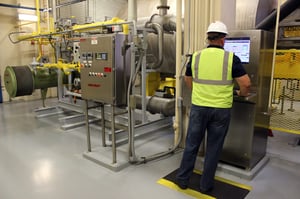Proactive vs. Reactive Maintenance
Facility managers everywhere know the struggle — an asset breaks down and technicians have to rush to react and repair it. Unexpected downtime leads to loss of operational hours and puts a kink in your workflow. Extreme damage can even result in asset loss, pushing the facility to the brink of financial disaster.
But it doesn’t have to be a constant battle against the tide. Proactive maintenance plans can significantly increase an organization’s preparedness to deal with asset downtime and reduce the chances of catastrophic failure. This article will break down the differences between proactive and reactive maintenance and explain why all facilities should consider implementing a proactive maintenance plan.
What Is Proactive Maintenance?

Think of your personal vehicle — do you change the oil every 5,000 miles, or do you wait for the engine to overheat and wear out from old oil? The same concept applies to physical assets like factory machines.
Proactive maintenance encompasses an organization’s planned efforts to perform routine maintenance and updates on equipment. It can include tasks such as predictive maintenance, where a single part is replaced when it reaches the end of its usefulness. It can also involve investment in technology like FacilityONE’s CMMS solution that monitors assets and helps users identify potential problems before they become serious.
 What Is Reactive Maintenance?
What Is Reactive Maintenance?
Reactive maintenance is exactly what it sounds like: you have a problem and react to it. It’s always necessary to have a reactive plan because problems happen, but having only a reactive plan is risky. It’s kind of like only having a plan for how to clean up after a hurricane has struck your home but not having a plan for staying safe and keeping damage to a minimum beforehand.
Reactive vs. Proactive Maintenance
Both forms of maintenance come with pros and cons. Reactive or corrective maintenance plans are often fairly intuitive: for example, if the machine is not running, taking it apart to find the cause of the problem and repairing the faulty part is a logical sequence of events. It is also more cost-effective in the short term and requires no special technology, a small maintenance team and limited investments in monitoring activities. Some organizations embrace the “run to failure” method which allows less essential equipment to run until it breaks down, then replace it. This method produces excess waste in both energy consumption and the parts of the asset or equipment, especially if the parts don’t reach their lifespan potential.
Having a reactive plan is absolutely vital to any organization, because asset failures still occur even to the most prepared facility. But having only a reactive plan leaves your facility much more vulnerable to a slew of unpredictable problems, unexpected asset downtime, expensive repairs and even catastrophic asset loss.
Reactive-only plans also pose a safety hazard to workers. If you aren’t aware of your equipment’s condition, it could theoretically break down at any time,  including while workers are using it.
including while workers are using it.
Proactive maintenance prevents complex and costly repairs caused by these catastrophic failures or unexpected breakdowns. It involves cleaning, checking, monitoring and replacing parts that show signs of wear or have reached the end of their lifespan. By performing preventive maintenance tasks, users catch problems before they reach the point of no return.
Proactive maintenance’s biggest drawback is often the cost. Technology comes with a price tag, and so do the man-hours and spare parts required for performing maintenance tasks. But the costs of reactive maintenance are often far higher — a CMMS can pay for itself if it saves an asset from an early grave.
While nothing can be deemed 100% safe 100% of the time, performing routine maintenance on pieces of equipment helps keep workers aware of their condition and can spot potential hazards before they become a safety issue. Proactive maintenance protects workers, liability, assets and finances and makes your reactive maintenance plan a backup plan.
What are the challenges of your preventative maintenance tasks?
Manpower?
Budget?
Lack of knowledge & experience?
Get in touch with FacilityONE Technologies. We can show you how our Interactive Blueprint Operations System with CMMS capability can revolutionize your operations team.



